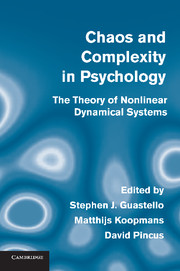Book contents
- Frontmatter
- Contents
- Contributors
- Preface
- 1 Introduction to Nonlinear Dynamics and Complexity
- 2 Collective Intelligence: Observations and Models
- 3 Neurodynamics and Electrocortical Activity
- 4 Psychophysics
- 5 Temporal and Spatial Patterns in Perceptual Behavior: Implications for Dynamical Structure
- 6 Embodied and Embedded: The Dynamics of Extracting Perceptual Visual Invariants
- 7 Origins of Order in Cognitive Activity
- 8 Nonlinear Complex Dynamical Systems in Developmental Psychology
- 9 Developmental Psychopathology: Maladaptive and Adaptive Attractors in Children's Close Relationships
- 10 Psychopathology
- 11 Coherence, Complexity, and Information Flow: Self-Organizing Processes in Psychotherapy
- 12 The Dynamics of Human Experience: Fundamentals of Dynamical Social Psychology
- 13 Group Dynamics: Adaptation, Coordination, and the Emergence of Leaders
- 14 Organizational Psychology
- 15 Complexity, Evolution, and Organizational Behavior
- 16 Agent-Based Modeling Within a Dynamic Network
- 17 Epilogue: Psychology at the Edge of Chaos
- Index
17 - Epilogue: Psychology at the Edge of Chaos
Published online by Cambridge University Press: 18 December 2013
- Frontmatter
- Contents
- Contributors
- Preface
- 1 Introduction to Nonlinear Dynamics and Complexity
- 2 Collective Intelligence: Observations and Models
- 3 Neurodynamics and Electrocortical Activity
- 4 Psychophysics
- 5 Temporal and Spatial Patterns in Perceptual Behavior: Implications for Dynamical Structure
- 6 Embodied and Embedded: The Dynamics of Extracting Perceptual Visual Invariants
- 7 Origins of Order in Cognitive Activity
- 8 Nonlinear Complex Dynamical Systems in Developmental Psychology
- 9 Developmental Psychopathology: Maladaptive and Adaptive Attractors in Children's Close Relationships
- 10 Psychopathology
- 11 Coherence, Complexity, and Information Flow: Self-Organizing Processes in Psychotherapy
- 12 The Dynamics of Human Experience: Fundamentals of Dynamical Social Psychology
- 13 Group Dynamics: Adaptation, Coordination, and the Emergence of Leaders
- 14 Organizational Psychology
- 15 Complexity, Evolution, and Organizational Behavior
- 16 Agent-Based Modeling Within a Dynamic Network
- 17 Epilogue: Psychology at the Edge of Chaos
- Index
Summary
I liked numbers because they were solid, invariant; they stood unmoved in a chaotic world.
Oliver Sacks, Uncle Tungsten: A Chemical Boyhood, p.26Introduction
It is rewarding to contemplate the progress in the field of nonlinear dynamical systems (NDS) science based on the work presented in this volume. Dynamical systems approaches have had a significant influence in psychology ever since its early days. Piaget used equilibrium as one of its central tenets in his description of the dynamics of child development (e.g., Piaget, 1967; see also Chapter 8, this volume); Lewin (1947) similarly analyzed the dynamical processes of information exchange in groups in terms of tendency toward equilibrium (see also Chapter 14), and gestalt psychology emphasized the unified whole in perception over its constituent perceptual elements (Wertheimer, 1925, see also Chapter 6). The chapters presented here attest to the responsiveness of psychology to the latest developments in NDS, such as chaos theory, catastrophe theory, fractal geometry, and agent-based modeling, and they illustrate the extent to which these approaches have made inroads in most of the subdisciplines in psychology, such as cognitive, developmental, clinical, and organizational psychology. In each of these areas, NDS provides novel perspectives to long-standing questions to which traditional paradigms failed to offer satisfying answers; NDS inspires scholars to ask various questions about observed phenomena and offers new, more flexible modeling strategies.
- Type
- Chapter
- Information
- Chaos and Complexity in PsychologyThe Theory of Nonlinear Dynamical Systems, pp. 506 - 526Publisher: Cambridge University PressPrint publication year: 2008
- 1
- Cited by



